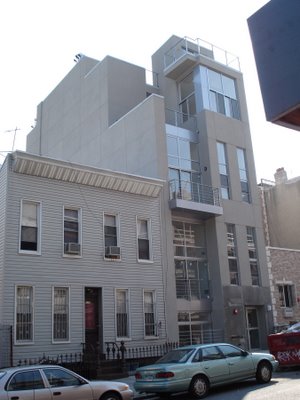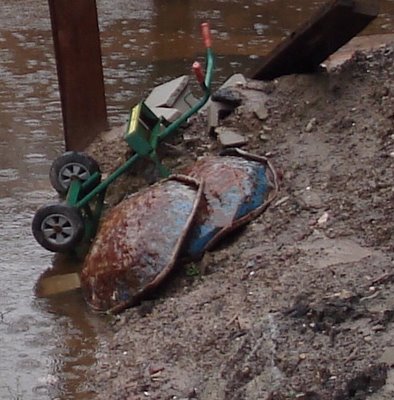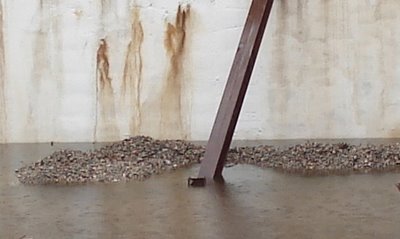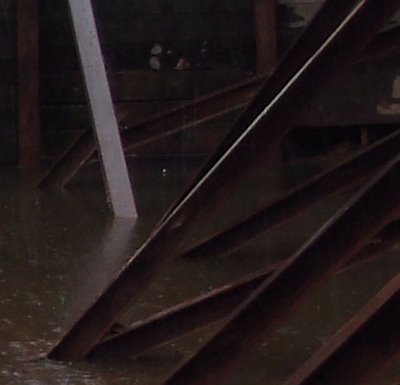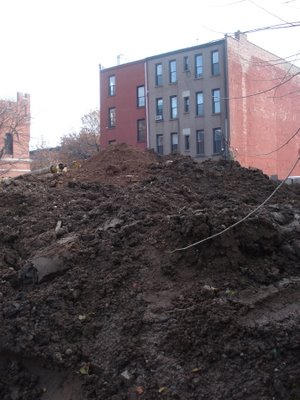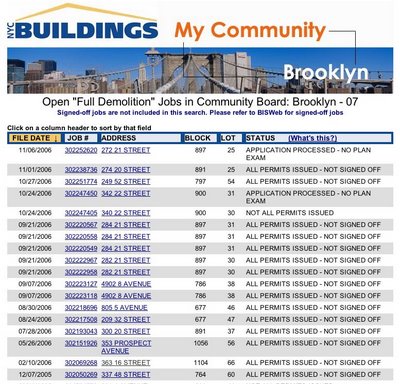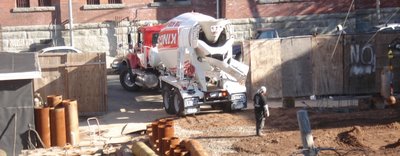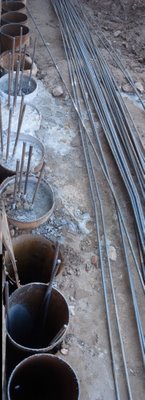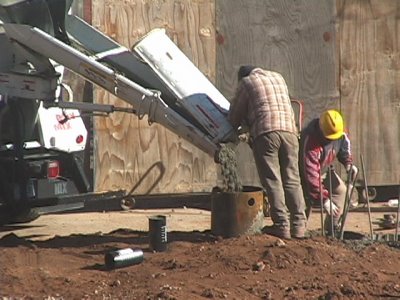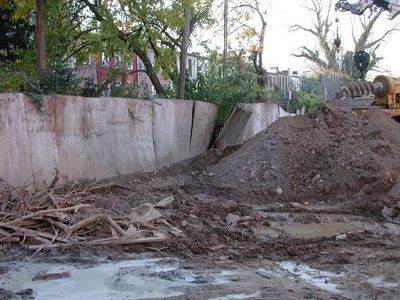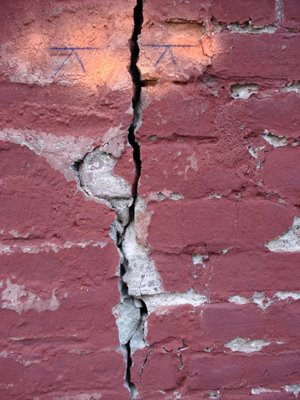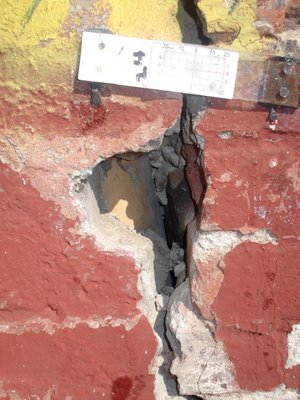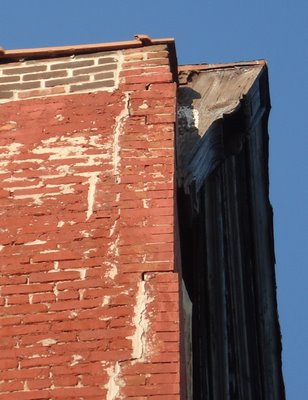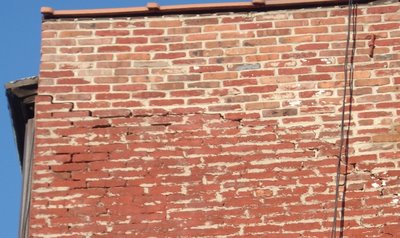Construction Zone Nightmare
98 Dead Since '01 as Builders Shirk Code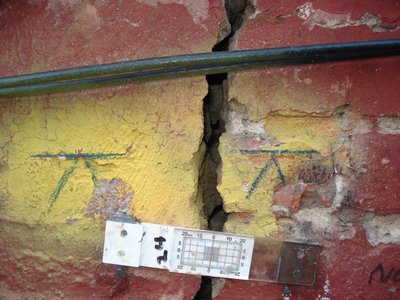
Click on the photo above to see 1504 Crack Tour video.
BY ROBERT GEARTY and BRIAN KATES
DAILY NEWS STAFF WRITERSDaniel Basilio (above) was killed Oct. 7 when the top floor of this Queens apartment house at 108th and Corona (below) collapsed during construction. Five others were hurt.
The death of Clever Jara, an immigrant worker killed in a fall from a scaffold last week, comes amid a massive construction boom marred by rising building code violations and flagrant disregard of zoning.
Jara was not hooked into a safety harness when he plunged 17 stories to his death while working on a building at 114 Fifth Ave., witnesses said.
The construction company he worked for, Town Restoration, did not have a licensed scaffold rigger or a required onsite foreman, the Buildings Department said.
Certificates showing that workers had been trained for the rigs also were not on the site, according to the department.
Such mishaps are increasingly common.
On Oct. 7, construction worker Daniel Basilio was killed and five others were injured when the ceiling of the Corona, Queens, building they were working on collapsed.
At least 98 construction workers in the city have been killed since October 2001, the federal Occupational Safety and Health Administration said. Jara was the 10th construction-related fatality since Jan. 1, according to the Buildings Department.
Many more have been injured. Between 2001 and 2005, OSHA investigated 68 "catastrophic accidents" citywide, meaning at least one worker died or three were seriously injured.
Because the vast majority of mishaps occur on nonunion jobs involving immigrant laborers, numerous additional cases are believed to go unreported.
"When a union guy is injured, reports are filed," said David Perecman, a personal injury lawyer who represents many immigrant workers. "But when they are illegal aliens, the boss tells them if it still hurts in the morning go to the hospital and tell them you tripped and fell."
On Thursday, the city formed a Scaffold Safety Task Force to develop safety enforcement and oversight policy.
The deaths and injuries come amid the biggest building boom in recent history. Last year alone, the Buildings Department issued 111,283 permits for demolition or construction — up from 62,739 in 1996.
Construction permits for this year are on pace to exceed 130,000, according to the latest figures available.
The city has rezoned some neighborhoods to protect them from the onslaught. But the move has created an unexpected consequence.
"Unscrupulous businessmen, seeing the opportunity for high-density, high-profit development in these neighborhoods slip away, are rushing to launch out-of-scale, out-of-character projects before the rezoning takes effect," Public Advocate Betsy Gotbaum testified at an Assembly hearing in September.
Last year, the city slapped vacate orders on 998 properties and issued 5,006 stop-work orders. This year, the figures may climb even higher. By August, the latest month for which statistics were available, the city had issued 4,391 stop-work orders and required 1,091 buildings to be vacated.
"There are contractors who ... are doing it on purpose because they want the adjacent building to fall down or be vacated," Buildings Commissioner Patricia Lancaster said of the shoddy excavations.
In an interview with the Daily News, Lancaster refused to name names. But this much is certain: At the heart of the problem is a cadre of well-known scofflaw developers and shady architects who abuse the Buildings Department's flawed honor system, which allows them to self-certify their work for zoning and building code compliance.
According to the Mayor's Management Report, 43% of all building plans in fiscal 2005 were self-certified. Of those, only 18.9% were audited. And of those audited, 16% had permits revoked.
Take developer Mendel Brach and his association with tainted architects Robert Scarano and Henry Radusky — poster boys for building boom boondoggles.
The Buildings Department has accused Scarano of ignoring zoning rules or building codes at no less than 26 Brooklyn apartment buildings, and three workers have been killed at buildings whose plans he vouched for.
Brach and fellow developer Moshe Oknin teamed up with him in the race to build an apartment tower at 144 N. Eighth St. in Greenpoint, Brooklyn, before the block was down-zoned.
Opponents of the project have dubbed it the "finger building," likening it to an obscene gesture in the low-rise neighborhood.
Scarano submitted plans for roof decks over two of businessman Scott Spector's adjacent properties to meet an "open space" requirement that would allow the building to rise above 10 stories.
Spector sued Scarano, Brach and Oknin, charging they had no right to build over his property and that they also tore down another of his buildings without permission.
In court papers, Brach denied the allegations and says they were made after the developers turned down Spector's demand that they buy the building in question for $17 million, "a price far in excess of the value."
The Buildings Department has ordered the developers to stop construction of the violation-riddled building at the 10th floor. But Brach hasn't given up. He has filed for summary judgment that would allow him to build to 16 stories. The case will be argued in Brooklyn Supreme Court on Nov. 13.
At 96 Diamond St., another Scarano building in Greenpoint, excavation caused the basement wall in a neighboring house to buckle and crack.
Forced to vacate, Alice Bajno — whose family had lived in the house for 40 years — sued Scarano and developer Christopher Cielepak for $1 million. "It was like an earthquake," Bajno said of the damage.
In an affidavit, Cielepak said the "crack developed apparently as a result of heavy rains which occurred around the time of excavating." The suit has not been resolved. Then there's Radusky.
He was the architect for five Brach buildings on a block of small homes on Spencer St. in Bedford-Stuyvesant, Brooklyn. Brach took advantage of an academic-use zoning exemption — the buildings were to be used to house teachers for a yeshiva — that allowed the buildings to rise to nine stories. Radusky certified the plans.
Problem is, the apartments were not marketed to yeshiva faculty as promised. They sold on the open market for about $25 million. When city officials learned of the deception, they refused to grant certificates of occupancy, leaving residents unable to sell or refinance their apartments.
New plans have been drawn up and the tenants are seeking a new architect, said Brach's attorney, Franklyn Snitow.
Radusky tried to pull the academic-use ploy again for an 11-story building in the Armory Plaza development at 406-408 15th St. in Park Slope, Brooklyn — even though the exemption had been wiped from the books months before.After heated community opposition, the Buildings Department revoked the permit and reduced the height to five stories.
Meanwhile, however, excavation caused cracks in the walls of an adjoining eight-family apartment building,
forcing the residents to leave.Both Scarano and Radusky have settled Buildings Department charges and have agreed to drop out of the self-certification program. But you'd never know that if you visit the department's Web site. Their names are not included on the list of disciplined architects.
Indeed, of the 34 architects and engineers who lost self-certification privileges this year and last, only four are named on the Web site. The rest have escaped public exposure in plea bargain-like deals, Lancaster admitted.
Moreover, none of them has been barred from practicing.
Few ever are.
Since 1995, the Buildings Department has asked the state Education Department, which licenses professionals, to discipline 132 architects and engineers. Only 31 have been fined or had their licenses suspended or revoked.
This year, the Buildings Department announced a pilot program to audit all self-certified plans. But it is limited to zoning conformity outside Manhattan.
Building code compliance will continue to be audited randomly.
Killed on the jobAt least 98 construction workers in the city have been killed since October 2001, most of them in mishaps involving violations of safety regulations or building codes. Here are just a few:
Oct. 7, 2006: Daniel Basilio, 29, was killed and five other workers injured when the fourth floor of a building at 104-56 Roosevelt Ave. in Corona, Queens, pancaked under the weight of freshly poured concrete. The owners, Galindo and Ferreira Corp., were cited for three violations, including failing to protect the property during construction.
March 8, 2006: Anthony Duncan, 47, was killed when a garage wall collapsed at 733 Ocean Parkway in Flatbush, Brooklyn. Architect Robert Scarano, cited for violations throughout Brooklyn, had signed papers taking responsibility for the shoring-up. Owner Viera Novak and developer Ari Chitrik of O.P. Equities were cited for, among other things, failing to safeguard the public and the property.
Nov. 2, 2005: Heng Zheng, 50, fell to his death at 207 South First St. in Williamsburg, Brooklyn. Leeco Construction Co. was issued two citations for not putting guardrails on the floors.
Aug. 29, 2005: Arturo Gonzales, 27, was struck and killed by an 800-pound steel girder at 187 20th St. in Sunset Park, Brooklyn. The Buildings Department fined 187 20th St. Realty $400. The department also fined owner Fasten Luzer $1,000 for failing to protect an adjoining structure during excavation, which caused the foundation to crack. The plans were certified by Scarano.
June 1, 2005: Mohamadou Jabbie was killed in a 60-foot fall from a scaffold at 345 Eldert St. in Bushwick, Brooklyn. Federal prosecutors arrested contractors Nasir Bhatti and Tariq Alamgir of Metla Construction for failing to provide fall protection equipment. Additionally, they charged Alamgir with ordering a witness to lie to investigators. The case is pending.
June 7, 2004: Worker Jian Guo Shen, 43, was killed in the collapse of a foundation wall at 51-18 92nd St. in Elmhurst, Queens. Developer Chi Yong Fa was fined $1,000.
May 20, 2004: Angel Segovia, 37, fell 35 feet to his death and three other workers were seriously injured when the third floor balcony at 9718 Fort Hamilton Parkway, Brooklyn, collapsed. None of the workers had federally mandated safety gear. Contractor Kang Yeon Lee pleaded guilty to causing the death and was sentenced in Brooklyn Federal Court to 30 months in prison and two years of supervised release. He agreed to pay more than $2 million to compensate victims and satisfy penalties in that case and another stemming from his failure to pay workers the prevailing wage on a project at JFK Airport.
May 16, 2002: Antonio Romano was killed and three workers injured when the weight of cinder blocks cause a collapse at 33 E. 61st St. in Manhattan. The Manhattan district attorney's office indicted contractor Shukun Tam and foreman Cheung Keat Ai for second-degree manslaughter, assault and reckless endangerment. Tam was acquitted of all but second-degree reckless endangerment, a misdemeanor. Ai pleaded guilty to lesser charges.
Oct. 24, 2001: Five workers were killed and four others seriously injured in the collapse of a scaffold 160 feet high at 215 Park Ave., Manhattan. Philip Minucci of TriState Scaffold pleaded guilty to second-degree manslaughter. In sentencing him to 3½ to 10½ years, Manhattan Supreme Court Justice Rena Uviller said the collapse "was not a tragic accident" but "a tragic certainty."
Hundreds forced to leave homesHundreds of New Yorkers have been forced to flee their homes because dangerous construction nearby damaged their foundations or raised fears their houses were unsafe.
Consider the case of Brooklynite Phyllis Mascia.
On June 16, 2005, work at 22 Havemeyer St. cracked the foundation of her home at 20 Havemeyer, forcing her and her two elderly sisters-in-law to vacate. They had lived in the building for 40 years.
"We were left homeless," said Mascia. "Three widows. We had a lovely life. It was our castle."
One of the Mascia widows, Filomenia, 92, went to a nursing home. Another, Antonetta, 87, moved in with relatives. Phyllis, 68, said she was temporarily housed by her insurance company in a hotel near LaGuardia Airport. "It was frightening," she said. "I don't think it was safe there for a woman alone."
She has since moved into an apartment at 45 Havemeyer "to keep an eye on" the empty house, which had been ransacked in her absence, Mascia said.
Mascia has sued Mike Choi, the owner of 22 Havemeyer. She was joined by Ana and Luis Jaramillo, who were forced to vacate 24 Havemeyer with their two children.
"I am not against development," Mascia said. "But when it is done dangerously, people can be killed or left homeless."
"We are sorry for what happened," said Choi's lawyer, Allen Schwartz. But, he added, "Whatever happened, happened beyond our control." He said Choi has sued the contractor and demolition company.
Meanwhile, Antonetta Mascia died Oct. 20. "I believe my sister-in-law would be alive today if she had not been forced to leave her home," Phyllis said.
Originally published on November 4, 2006
AMEN!
For a complete history of the on going construction boom and recent down zoning in the South Park Slope and Green Wood Heights Brooklyn neighborhoods, visit the South South Slope community web site at www.southsouthslope.comPlan on spending a good amount of time there.





















